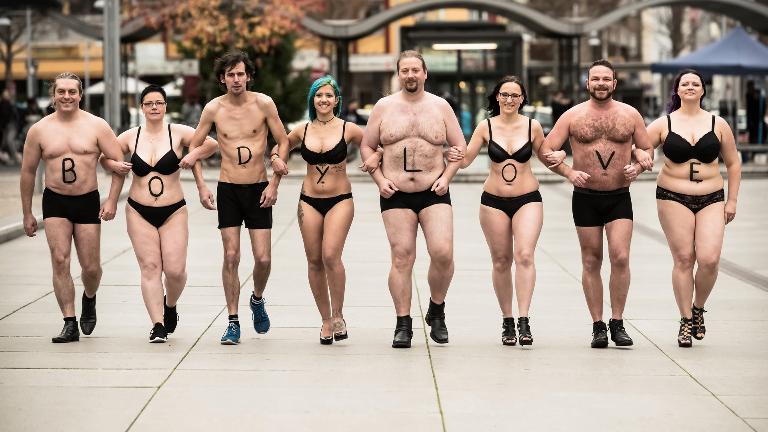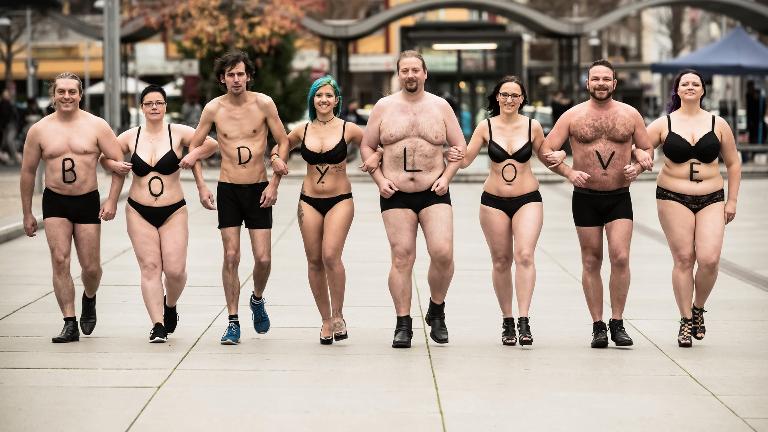Body Positivity

What does it mean to be Body Positive?

Shame masked as pride, or its pursuit,
is not body positivity.
I’ve seen a lot of posts online about body positivity. I never related to it and that is mainly because I was unknowingly body shaming myself. After realizing I was indeed shaming I wanted to know what it means to be ‘Body Positive’ and to stop ‘Fat Shaming’ and what terms like ‘BoPo’ actually meant. Some have (inaccurately) claimed that body positivity gives reason to eat unhealthy foods, encourage weight loss/gain and even conform to a certain body type. Do not be limited to these beliefs. In this article you will hear from people that started the movement and explain what it actually means.
The term Body Positivity and its movement is defined by Payton Ramey, University of Central Florida on Study Break as:
Body Positivity Movement is meant to encourage everyone, regardless of religion, gender, sexual orientation, race, age, weight or disability, to love and appreciate their bodies.
Based on the 2016 article from Psychology Today, “What Does Body Positivity Actually Mean? I find my answers from the women that began this movement. To answer it in two words, Body Positivity is another way of saying Body Acceptance – which I think is a more accurate definition by Mallorie Dunn.
“To me, body positivity means accepting the body you have as well as the changes in shape, size, and ability it may undergo due to nature, age, or your own personal choices throughout your lifetime. It’s the understanding that your worth and what’s going on with you physically are two separate entities — that no matter what’s happening inside, outside, or to your body, you’re still just as worthwhile as the person next to you.”
So what is the next step? Based on Connie Sobczak, one of the founders of thebodypositive.org answers what one can do to be ‘body positive’,
“To be body positive, it is important to assume responsibility for figuring out what your body needs. In many ways, this feels harder than having an external “expert” voice tell you what to eat and how to move. But playing with the word “responsibility” makes it much less intimidating: response ability simply becomes the ability to respond to the stimuli present. In this case it is the ability to respond to sensations of hunger or fullness and the need for movement or rest. Honor the life and circumstances that make it difficult at times to take care of yourself the way you would like and simply do the best you can in the moment. Be willing to trust your ability to know what feels good for your unique body. Learn from trial and error, and be kind to yourself when you make mistakes.”
I think it is so key to accept those ‘trials and errors’ in life as an opportunity to learn more about oneself. This is exactly what CreateBeing is; one’s journey to self knowledge/development. We have to learn from the lows to see what it means to be high. 🙂 (That isn’t suppose to be a 420 joke but it fits right in doesn’t it? haha)
:p
Media representation
I am not a one dimensional person, why would what inspires me be limited to One type?
Of course we can’t have a discussion about body image with out discussing ‘the media’. Many recognizable companies like Seventeen, Sports Illustrated, even Mattel’s Barbie has a revised ‘look’. Having different body types, less image editing, and more options for clothing sizes are what companies have been doing to join this movement. When it comes to exposure of what we see and accept as beautiful, we must take responsibility in the matter. For one thing, if you are only looking at one type of body for inspiration, consider the trend and its affect on you. Are the images of body types similar? How does this make you feel? There was a time in my life I read teen magazines and decided to stop reading them. It was an experiment to see how these images affected me. Truth be told I didn’t think I had body image issues then until I took those images away. After a year I wanted to see if I saw the images in the magazines differently so I started picking them up again and recognized the way it made me feel. I wouldn’t say it was positive.
Personally, when I see an Asian Women in the media I get excited. I am one and rarely saw/see them represented. As a adolescent I only saw one cool Asian – The Yellow Ranger from Power Rangers. Then as a young adult I saw Lucy Lui. She was a great role model but know that I still couldn’t relate to her looks. Anyways the point is I didn’t grow up with many to represent me in media and wanted to see myself in them to identify. However, if all the represented Asians I see are all skinny or have similar roles, then I am presented with women that I truly cannot relate. It doesn’t mean I don’t look up to Asian women, it just means I have to mix it up.
(Side Note: Asian representation has been top of mind. I am sure an article will be written. Let me know if you’re interested)
This brings to mind the movie on Netflix, LIBERATED (2017) in which one of the speakers says that the more images we see that are alike, the more we believe that we are to only see beauty, cool-ness and/or behaviour to look a certain way. If we had a variety of images we would see that there are more options of what we can be and look like. You can read this Film Friday blog, here.
Take Shape
Just because you are seen as curvy, thick, thin, skinny, or whatever words used to describe bodies, we must not forget the importance of what we say to ourselves in our heads. I am so moved when a ‘skinny’ person is being shamed for their body shape while stating their body acceptance. This person feels this way about their body. It is the same way a ‘curvy’ person should not be shamed for their size. It is a mirror effect that I don’t understand. In fact, I see it is more shaming that we all don’t need. It really solidifies the thinking that we all have our woes. Just because a person is ‘skinny’ doesn’t make them less susceptible to body image dysmorphia. Check out articles like Battling Our Bodies: Understanding and Overcoming Negative Body Images. My thinking is to not discredit someone’s experience based on what you think they should/shouldn’t be. Perfect example is Jessamyn Stanley seen in the video to the right.
“Typically if you are a fat girl and want to do any kind of exercise they always want you to cover up. And for me to say Fuck that noise I’m going to be myself and wear what I want. That is weaponry; that is how we change lives. – Jessamyn Stanley“
We are all in this together
When it comes to acceptance and love for yourself it is always good to keep in mind that we are not alone. Based on the app Whisper, 45.5% of users say “encouraging each other” is the best way to promote body positivity.
To me that says it all. It is a nice reminder there is a community out there that is welcoming you.
Shout out
On that note, I want to give a shout out to those out there who takes pictures of themselves and show off who they are; giving moments of highs and lows as they share their journeys to self acceptance. This to me is what self love is. I appreciate what you do, it helps people like me learning to do the same. You can follow hashtags like #bodypositivity or #curvygirl if you want to see what people are up to. I know for me having more of these images in my feed have exposed me to other body types.

Excellent way of describing, and good piece of writing to get facts about my presentation subject,
which i am going to present in college.